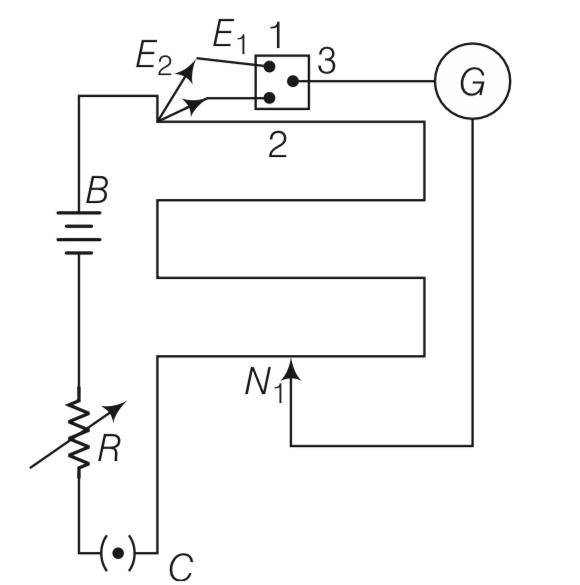Electricity
Get insights from 73 questions on Electricity, answered by students, alumni, and experts. You may also ask and answer any question you like about Electricity
Follow Ask QuestionQuestions
Discussions
Active Users
Followers
New answer posted
6 months agoContributor-Level 10
This is a Long Answer Type Questions as classified in NCERT Exemplar
Explanation – let R' be the resistance of potentiometer wire.
Effective resistance of potentiomter and variable resistor r=50ohm is 500+R'
Effective voltage across potentiometer = 10V
The current through main circuit I= =
Potential difference across wire of potentiometer
IR'=
Since with 50 ohm resistor, null point is not obtained it is possible when
10R'
2R'<400 or R'<200 ohm
Similarly with 10 ohm resistor, null point is obtained its is only possible when
2R'>40
R'>40
7.5R'<80+8R'
R'>160
160
Any R' between 160 ohm and 200 ohm will achieve.
Since the null point on the last 4th segment of
New answer posted
6 months agoContributor-Level 10
This is a Long Answer Type Questions as classified in NCERT Exemplar
Explanation – power consumption in a day i.e in 5 = 10 units
Power consumption per hour = 2 units
Power consumption = 2 units =2KW= 2000J/s
Also power =V I
2000W= 220V l or l= 9A approx.
R=
Power consumption in first current carrying wire
P= I2R
l2= 1.7 10-8 j/s = 4J/s approx.
Loss due to joule heating in first wire = 100=0.2%
Power loss in Al wire =1.6 4= 6.4J/s
Fractional loss due to joule heating in second wire = 100= 0.32%
New answer posted
6 months agoContributor-Level 10
This is a Long Answer Type Questions as classified in NCERT Exemplar
Explanation – power consumption in a day i.e in 5 = 10 units
Power consumption per hour = 2 units
Power consumption = 2 units =2KW= 2000J/s
Also power =V I
2000W= 220V l or l= 9A approx.
R=
Power consumption in first current carrying wire
P= I2R
l2= 1.7 10-8 j/s = 4J/s approx.
Loss due to joule heating in first wire = 100=0.2%
Power loss in Al wire =1.6 4= 6.4J/s
Fractional loss due to joule heating in second wire = 100= 0.32%
New answer posted
6 months agoContributor-Level 10
3.23 Internal resistance of the cell = r
Balance point of the cell in open circuit, = 76.3 cm
An external resistance R is connected to the circuit with R = 9.5 Ω
New balance point of the circuit, = 64.8 cm
Current flowing through circuit = I
The relation connecting resistance and emf is,
r = ( )R = 1.69 Ω
Therefore, the internal resistance is 1.69 Ω.
New answer posted
6 months agoContributor-Level 10
3.22 Constant emf of the standard cell, = 1.02 V
Balance point on the wire, = 67.3 cm
A cell of unknown emf, , replaced the standard cell. Therefore, new balance point on the wire, l = 82.3 cm.
The relation of connected emf and balance point is, =
Hence, = = = 1.247 V
The purpose of using high resistance of 600 KΩ is to reduce the current through the galvanometer when the movable contact is far from the balance point.
The balance point is not affected by the presence of high resistance.
The point is not affected by the internal resistance of the driver cell.
The met
New answer posted
6 months agoContributor-Level 10
3.21 Let the equivalent resistance of the given circuit be R'. The equivalent resistance of an infinite network is given by
R' = 2 + or R' = or + R' = 2R' + 2 + R'
R' = = 1
Since R' cannot be negative, hence R' = 1+ = 2.73 Ω
Internal resistance, r = 0.5Ω
Total resistance = 2.73 + 0.5 = 3.23 Ω
Current drawn from the source = A= 3.72 A
New answer posted
6 months agoContributor-Level 10
3.20 Total number of resistors = n
Resistance of each resistor = R
When the resistors are connected in series, effective resistance is maximum. = nR
When n resistors are connected in parallel, the effective resistance, is minimum. = . The ratio of maximum to minimum resistance = =
Let us assume, = 1 Ω, = 2 Ω, = 3 Ω
Required equivalent resistance, R = Ω

From the circuit the equivalent resistance is given by
R = + 3 = + 3 = Ω
Required equivalent resistance, R = Ω

From the circuit, the equivalen
New answer posted
6 months agoContributor-Level 10
3.19 (a) Alloys of metal usually have greater resistivity than that of their constituent metals.
(b) Alloys usually have much lower temperature coefficients of resistance than pure metals.
(c) The resistivity of the alloy manganin is nearly independent of increase of temperature.
(d) The resistivity of a typical insulator (e.g., amber) is greater than that of a metal by a factor of the order of 1022.
New answer posted
6 months agoContributor-Level 10
Q.3.18 (a) When a steady current flows in a metallic conductor of non-uniform cross section, only the current flowing is constant. Current density, Electric field and Drift speed are inversely proportional to the cross section area, hence not constant.
(b) Ohm's law is not applicable to all conductors, vacuum diode semi-conductor is a non-ohmic conductor.
(c) According to ohm's law V = IR, voltage is directly proportional to current, hence to draw high current from a low voltage source, internal resistance ®, needs to be low.
(d) To prevent the drawing of extra current, which can cause short circuit, the internal resistance for
New answer posted
6 months agoContributor-Level 10
3.17 From Ohm's law, R =
From the given table we get = = …………… = constant
Hence manganin is an ohmic conductor.
Taking an Exam? Selecting a College?
Get authentic answers from experts, students and alumni that you won't find anywhere else
Sign Up on ShikshaOn Shiksha, get access to
- 65k Colleges
- 1.2k Exams
- 681k Reviews
- 1800k Answers









